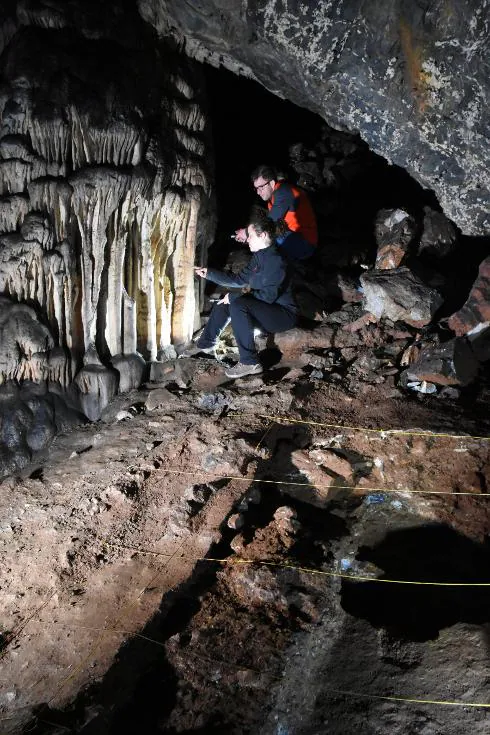Ardales, the birthplace of cave art
A team of scientists have proven that paintings in the cave are 20,000 years older than our species
FERNANDO TORRES
Lunes, 5 de marzo 2018, 14:26
The prehistoric cave of Ardales continues to be full of mysteries, but the scientific community is gradually uncovering more of them. This archaeological site, which was forgotten for centuries and discovered by the first researchers nearly 100 years ago, has been the subject of a new international study and the results have just been published in the prestigious journal, Science.
According to datings from the precise uranium-thorium technique, the wall paintings in the cave are 20,000 years older than the time most historians have believed that prehistoric art began. Together with the caves of Maltravieso (Cáceres) and La Pasiega (Puente Viesgo, Cantabria), which were also studied, Ardales was the home of one of the first paintings in humanity. Researchers have concluded that the most ancient art in Europe was not, after all, produced by Homo sapiens, but by the Neanderthals.
The research, which was carried out in different stages by academics and institutions from five countries, used the uranium-thorium method (known in the field of science as U/Th dating). This procedure, as Pedro Cantalejo, who is responsible for heritage in Ardales and for the cave, explains, enables us to date the incrustations and calcitic formations which are in direct contact with the wall paintings. It enables definite dates to be known for the calcitic incrustations associated with figures in paleolithic style, especially those which were not done with organic materials.
This overcomes the limitations of 14 AMS carbon and the problem of preservation, says Cantalejo, because during this process none of the colouring material of the figure has to be removed. It also avoids possible contamination of the sample, in that the uranium series dates geological processes and does not produce contamination during the collection or subsequent handling in the laboratory.
As the extensive article in Science explained, U/Th dating enabled the researchers to confirm that the wall paintings at Ardales, Maltravieso and La Pasiega are the oldest in the world. It can be certified that the origin of the art goes back at least 65,000 years, not 40,000, concludes the study. The dating shows that a red line in La Pasiega cave was painted at least 64,800 years ago, that a negative red hand in Maltravieso cave was drawn at least 66,700 years ago and a formation of speleothems in Ardales cave was decorated with elongated or pseudo-ellipsoidal red concentrations at least 65,500 years ago.
These results bring a new focus to the scientific debate about the origin of cave art in the world, a conversation which has been heightened in recent years due to new findings. Traditionally, artistic abilities have only been attributed to the first populations of modern humans who arrived in Europe. Despite this, in the past few years several discoveries have been made which suggest that earlier human groups such as the Neanderthals used to paint their bodies red and paint or carve small signs on bones and stones, says Pedro Cantalejo.
In the case of the Ardales Cave - situated in the extreme west of Europe and considered to be a home of the last Neanderthals - chronological research supports the results which are being obtained from the archaeological excavations carried out by the international team from 2011 onwards.
This conclusion shows the great potential of the sites in Malaga, says Cantalejo, for whom it is also a way of validating the efficiency of new technologies applied to methods of archaeological study. The Ardales Cave contains more than 1,000 prehistoric drawings from the paleolithic period. They were studied, catalogued and published in 2006. Since then, these new mechanisms have enabled definite dates to be known and there is no doubt about their previously unsuspected age.
The results of the study in the Science journal were presented by the University of Cadiz, which participated in the project, last week. The presentation was attended by Professor of Prehistory José Ramos; the director of the Neanderthal Museum in Germany, Gerd-Christian Weniger; the chancellor of the university, Eduardo González Mazo; the Junta de Andalucía's Minister of Culture, Miguel Ángel Vázquez; and the mayor of Ardales, María del Mar González.
International funding
The project was funded by the Natural Environment Research Council (UK), National Geographic Society (USA), Max Planck Society (Germany) and the Royal Society Wolfson Research Merit Award (UK). Ardales council provided support for the field work.
Dr Gerd-Christian Weniger of the Neanderthal Museum is proud of the results of this project. It is the end of a process which has taken many years; we know that this will change the way in which we study history, he said, and it also will put an end to a discussion between experts which has lasted over 25 years.
The mayor of Ardales said she had been excited to form part of the process by providing logistical support for the research. She explained that the cave has always been, and always will be, important for the municipality. We have a great affection for it, she said.
The Ardales cave still has more stories to tell. The gallery over the main chambers has not yet been excavated and experts believe there used to be a connection with the Sima de las Palomas chasm in Teba. The works would be costly and complicated, but they would shed further light on the fascinating history of this small village in Malaga province.
